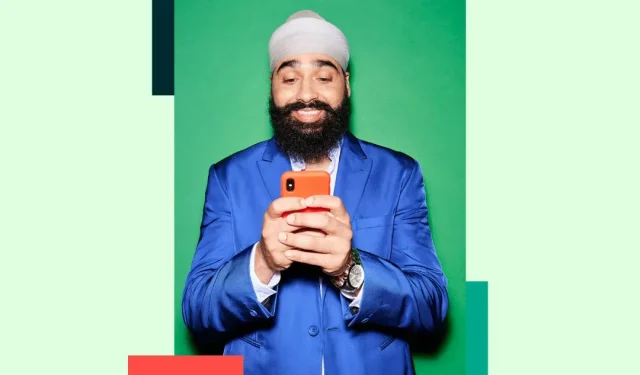Social media and politics have become intimately intertwined ever since then-candidate Barack Obama used social media to launch a massive 2008 presidential campaign that engaged voters and donors in ways never before seen in federal politics.
In 2008, Obama had five million followers on 15 social networks. In contrast, Alexandria Ocasio-Cortez has 8.6 million followers on Instagram alone today. Donald Trump has 87.5 million Twitter followers.
Whatever you think about the role of social networks in politics, it is safe to say that they have become an essential component of political campaigns. Learn about facts, statistics and best practices for using social media in politics.
Social Media and Politics: Statistics and Facts
1. Since May 2018, US advertisers have spent $3.79 billion on meta ads about “social issues, elections, or politics.”
This is the same as the data in the meta ad library, which shows all ad spend in that special ad category. During this time, about 15 million ads were placed in this category.

Source: Meta ad library report.
All-time spending leader is Mike Bloomberg 2020 Inc. The campaign spent over $63 million promoting Mike Bloomberg’s Facebook page during his presidential campaign.
2. American political candidates posted nearly 14,000 tweets a day in October 2022.
This is based on a Pew Research analysis. It reviewed the bills of more than 8,000 federal, state and local candidates ahead of the midterm elections. In the 10 months leading up to the midterm elections, they posted nearly 3.4 million tweets.
3. 38% of Democrats trust social media information compared to 27% of Republicans.
In general, Americans are increasingly getting their news from social media (more on that later). But they still distrust the information they find on social media almost as much as they do the information they get from more traditional media organizations.
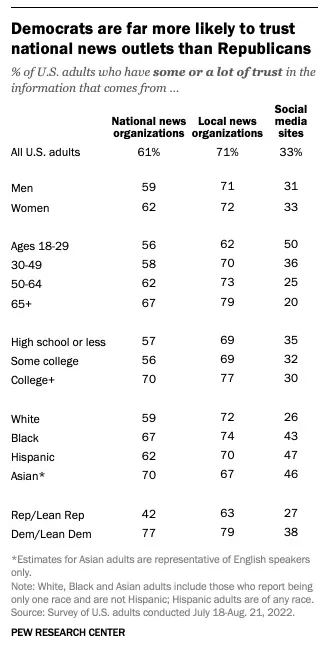
Source: Pew Research Center.
However, Democrats and those leaning to the left are far more likely to trust the information they find on social media than their Republican counterparts.
The opinion of Republicans about the impact of social networks on politics and public opinion in general is also more negative than that of Democrats. For example, 83% of Democrats consider social media to be an effective tool for raising public awareness of political or social issues. But only 71% of Republicans agree.
4. 23% of US social media users post on political topics.
On Twitter, the number is much higher, with 45% of American adults saying they have tweeted about political or social issues in the past year. And 33% of Twitter content contains some form of political content.
5. 87% of social media users in advanced economies believe that social media is good for democracy.
In general, people say social media has the biggest positive impact on keeping up with current events—both locally and globally. The largest perceived negative impact is related to the possibility of misinformation.
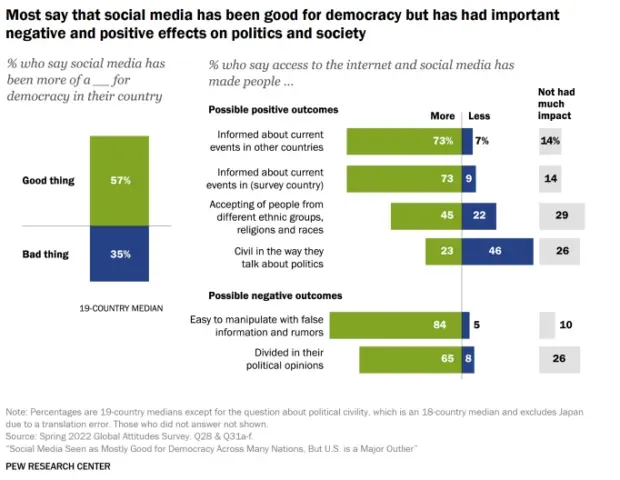
Source: Pew Research Center.
6. But 64% of Americans think social media is bad for democracy.
The United States is one of three countries surveyed where most people believe social media is bad for democracy. The others were the Netherlands (54%) and France (51%).
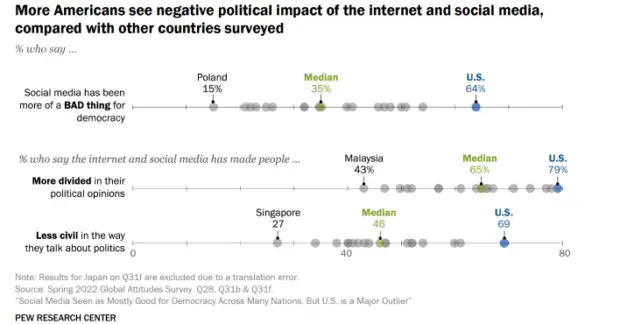
Source: Pew Research Center.
Social networks – a source of news
Americans’ use of social media for news peaked during the 2020 lockdown and has only declined slightly since then. Half of Americans either occasionally or frequently get their news from social media.

Source: Pew Research Center Social Media and Newsletter.
Of course, sometimes social media is also a source of political news that ends up in more mainstream news outlets. For example, from early 2016 until his Twitter and Facebook accounts were suspended in January 2021, it was impossible to avoid news coverage of Donald Trump’s social media posts, even if you never visited the social media site.
Social media can be a place to post news or a place to create it, depending on how you use it.
Social networks are a platform for political campaigns
Social media is an effective campaigning platform to spread their messages and generate campaign funds.
It is a particularly important tool for engaging young voters in the democratic process. 47% are 18 to 29 years old in the US. say social media has a positive impact on democracy, compared to 23% of people over 50. This group of young people includes new voters who are eligible to vote for the first time.
Politicians and political campaigns use social media, including political social media advertising, to gain attention and support even outside of election cycles. Take a look at the Meta Ads Library to see which social media political campaigns are running ads on Facebook and Instagram in real time.
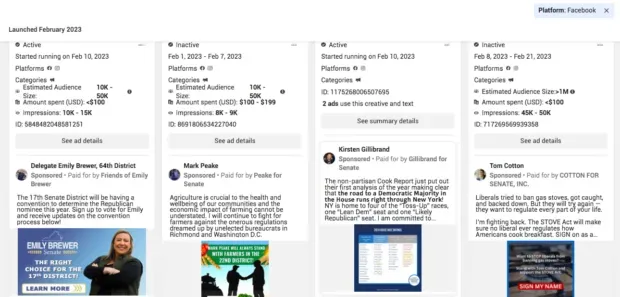
Source: Meta Declarations Library.
Social media can help increase voter participation
Go to the Vote (#GOTV) and voter education campaigns have become a staple on social media. Because these campaigns often aim to get more young people to vote, social media is a natural platform.
For example, Represent.Us, a non-profit organization, organized a social campaign in which celebrities were naked to explain the intricacies of mail-in voting (including the possibility of “naked ballots”being disqualified).
Rock The Vote has been encouraging youth to vote since 1990. Social media has become a key element of their work, reaching over 12 million people on social media in 2022.
@rockthevoteofficial Diddy in 2000 for our #RapTheVote campaign 🗳️ #RockTheVote #BlackHistoryMonth #Diddy #PDiddy #VoteTok #Throwback
And then there’s the dark side…
It’s impossible to talk about the power of social media in politics without admitting that it has gone wrong over the years. Perhaps the most famous example is the Cambridge Analytica scandal. The data of millions of Facebook users was secretly collected and used to “micro-target”voters in the 2016 US presidential election.
Twitter was also a source of questionable content and disinformation during the 2016 elections, including through content posted by Russian “coordinated influence accounts “.
In response, social platforms have expanded their rules for political content and especially political advertising on social media. Facebook has also excluded some forms of ad targeting.
Rules for Political Advertising on Facebook and Instagram
Meta has a specific set of rules for ads that fall under the “social issues, elections, or politics”category. These include advertisements for or about political candidates, GACs, elections, voting, social issues and other political advertisements.
These ads must go through an authorization process that includes verification of government ID and proof of address in the country in which the ads will be shown.
Listings in this category must have a disclaimer stating who paid for the listing, which is accessed through the “About this Listing”button.
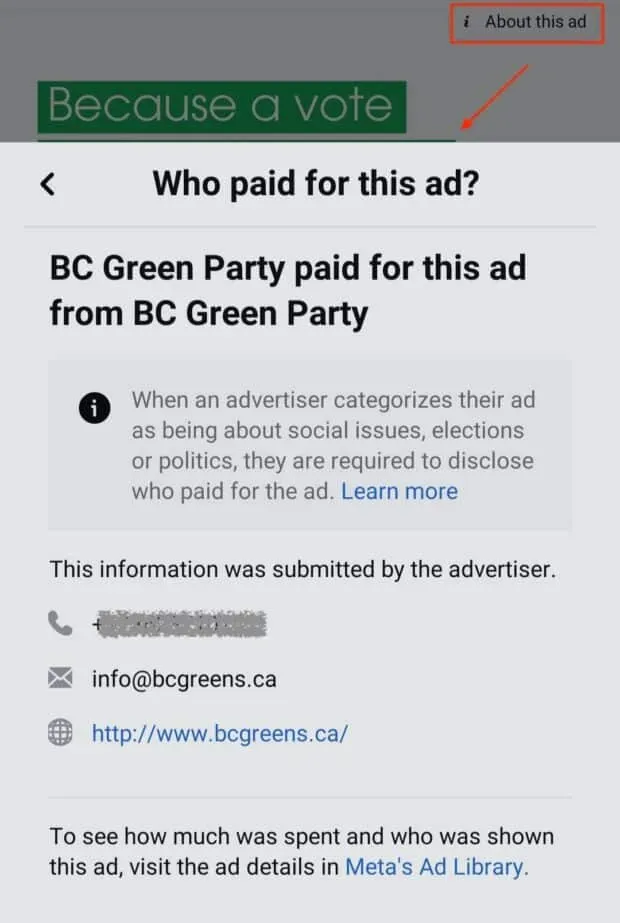
Source: Facebook
Political advertising rules on Twitter
The rules for political ads on Twitter vary by country. In many regions, political advertising is banned altogether.
However, political advertising is legal in the United States if it:
- Do not include false or misleading content
- Comply with disclosure and content laws
U.S. political campaign ads can only be promoted through boosted ads and follower ads (other types of ads are not allowed on Twitter). Advertisers must be based in the United States and must be pre-approved to run political campaign ads.
Rules for Political Advertising on TikTok
TikTok does not allow political ads. It is important to clarify that this includes political branded content – it is not allowed on the platform to pay creators to post political content.
TikTok blocking for government employees and devices
Many governments and government agencies have explicitly banned TikTok from work devices, or even employees’ personal devices as long as they are also used for work purposes. This includes at least 25 U.S. states, all U.S. government agencies, the U.S. Senate, the Canadian government, and the European Commission.
This affects many political campaigns, especially those led by actors whose employees are civil servants. Before you create a TikTok account or even download an app on your device, check with your employer if you are subject to a TikTok ban.
For more information on social media use after election, please see our social media and government and social media compliance posts.
1. Know where your audience is active
Any effective social media campaign starts with audience research. Where does your audience spend most of their time on social media?
This chart from Pew Research is a good place to start. For example, Facebook and YouTube have more Republican and Republican voter representation, while Reddit and Snapchat are favored by Democrats.

Source: Pew Research Center Social Media and Newsletter.
A solid social listening strategy will help you better understand who is already talking about your candidate or social issue online and what platforms they are using.
2. Post Consistently
It can be tempting to flood your social channels with content in the weeks or months leading up to an election and then shut up. This can cause followers to mute you (or even mute you) during the promotional blitz and forget about you when your account becomes inactive.
Instead, create a social media content calendar and post schedule to distribute your content in a more consistent manner. Yes, you will probably still be more active in the run-up to the election, but unless your candidate or case disappears from public life altogether, regular posting will keep your followers active so they are there the next time you need them.
Of course, this can be a problem for mass campaigns and candidates with a limited team. Social media scheduling tools like Hootsuite can help you make the most of your time by allowing you to upload content and schedule social media posts in advance.
Hootsuite also provides personalized recommendations for the best time to post so you can get the most exposure for your efforts.
3. Use Social Media to Raise Funds
Social channels are an important component of any political fundraising strategy. Consider linking to your donation platform in your bio and create content that explains how donations are used to further your political goals.
You can also use the “Donate Now”call to action button in meta ads to support your fundraising campaign.

Source: BC Green Party on Facebook.
Note that TikTok is an important exception here. TikTok policy prohibits campaign fundraising in any form. Specific examples that TikTok mentions include “a video from a politician asking for donations or a political party directing people to a donation page on their website.”Politics and money don’t go together on TikTok, so keep that in mind when planning your political social media campaign.
4. Post content that’s easy to share
Nearly ⅔ of American adult political tweets are actually retweets without any further action on the part of the user. Another 9% were tweets with quotes, and 25% were replies. Only 4% were completely original tweets.
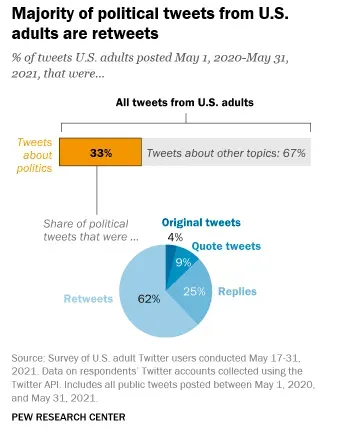
Source: Pew Research Center.
Make it easy for people to complement your message with interesting or inspiring social media content, whether it’s a whimsical tweet:
Roses are red, violets are blue. If any other major country can pay sick leave for its population, so can the United States.
— Bernie Sanders (@BernieSanders) February 15, 2023
Or an Instagram story to share a screenshot of:
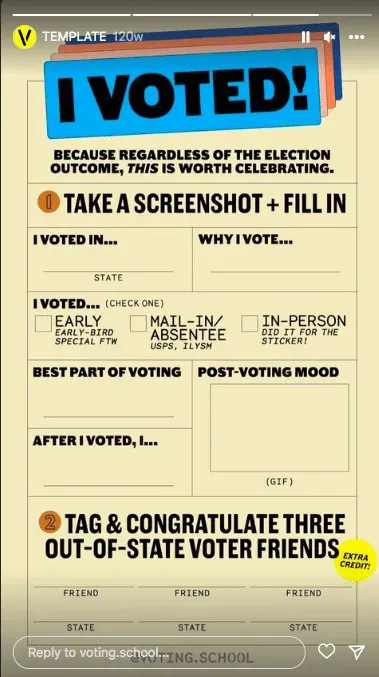
Source: @voting.school
5. Use Twitter to Get the Attention of Journalists
69% of American journalists say Twitter is the social network they use most or second to work. Facebook is next with 52%.
Additionally, a recent academic analysis found that politics and economics was the most common subject area for which news outlets used Twitter as a source.
If you’re trying to make or break social media news, Twitter is the way to go.
6. Use the right tone for each platform
User demographics vary significantly across social platforms. As a result, it’s important to test your tone and messaging on every platform you plan to use.
For example, a study of political social media posts leading up to the 2020 U.S. election found that photos of candidates who appear happy perform best on Instagram, while photos in which candidates appear calm perform best on Facebook.
Instead of posting the same content across all of your social media accounts, use custom cross-posting that tailors your content and messaging to each platform. Develop a social media testing plan to refine your platform-specific strategy over time.
